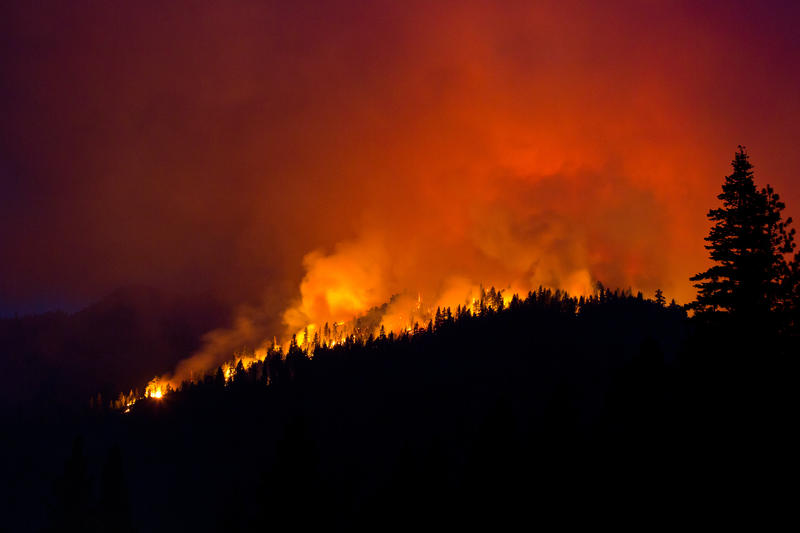Due to the quick pace at which a wildfire can spread, it’s likely we won’t have much of a chance to gather our things, develop an escape plan and move to safer location. As with any other natural disaster, you and your loved ones’ survival is dependent upon planning ahead.
Defensible Space and Wildfires
For natural catastrophes, it’s important to consider the concept of “defensible space”. From a wildfire perspective, a defensible space is an area around a structure where wood and vegetation are treated, cleared, or reduced to slow the spread of flames towards a structure.
Flatland fires spread more slowly than a fire on a slope (hot air and flames rise). A fire on a steep slope with wind blowing uphill spreads fast and produces “spot fires”.
You’ll want to thin out those thick canopied trees near your house.
Is Your Home Built of Flame-Resistant Materials?
- It might also be a good idea to consider brick, stone, and concrete, as they are all more resistant to fire than wood.
- Try to keep the amount of fuel (propane tanks, for example) near your home and/or property to a minimum.
- Beyond this, breaks in fire fuel – often termed firebreaks – are smart to have around neighborhoods and/or homes. Basically, these encompass a stretch of land with nothing that can burn on it.
How to Prevent a Wildfire
- Contact 911, your local fire department, or the park service if you notice an unattended or out-of-control fire.
- Never leave a campfire unattended. Completely extinguish the fire.
- When camping, take care when using and fueling lanterns, stoves, and heaters.
- Do not discard cigarettes, matches, and smoking materials from moving vehicles, or anywhere on park grounds. Be certain to completely extinguish cigarettes.
- Follow local ordinances when burning yard waste. Avoid backyard burning in windy conditions.
Before a Wildfire
1. Create an emergency plan.
- Assemble an emergency supply kit and place it in a safe spot. Remember to include important documents, medications and personal identification.
- Plan two ways out of your neighborhood and designate a meeting place.
2. Exercise caution as the wildfire approaches.
- Do not panic.
- Wear long sleeved clothes, cotton or wool, to protect your face and body from heat, hot ash and falling debris.
- Shut off all gas appliances as well as the main gas valve to your home.
- Turn on the lawn sprinklers and all water faucets to salvage the house.
During a Wildfire
1. Limit exposure to smoke and dust.
- Listen and watch for air quality reports and health warnings about smoke.
- Keep indoor air clean by closing windows and doors.
- Use the recycle or re-circulate mode on the air conditioner.
- If you have asthma or another lung disease, follow your health care provider’s advice.
2. Prepare to escape.
- Choose downhill, not uphill routes if possible.
- Stay away from dry, arid fuel potential, such as dead leaves, dry weedy fields, dead trees, etc.
- Try to select a route that is less flammable, if possible. If you must choose a wooded area as your escape route, pick leafy trees over pines.
- If you can’t escape, seek shelter in the ground.
- Find a cave, barren crevice, drainage pipe or an underground hole. Lay low and curled up. Cover any exposed skin (including face) to keep thermal burns at a minimum. Consider a fire blanket for emergencies.
- Dig a trench to lie in. Cover your body with a foot of soil. Only do this as a last resort. Try to create a small pocket under your face to trap oxygen.
- If you have time as you evacuate, choose cotton clothing and shed nylon apparel.
- When there is no other choice, run away from the fire
- After the fire passes, proceed upwind.
- Seek emergency help as soon as possible.
3. Know how to react if you’re trapped in your vehicle.
- Stay calm.
- Park your vehicle in an area clear of vegetation.
- Close all vehicle windows and vents.
- Cover yourself with wool blanket or jacket.
- Lie on vehicle floor.
- Use your cell phone to advise officials. Call 911.
4. Know how to react if you’re caught in the open.
- On a steep mountainside, the back side is safer. Avoid canyons, natural “chimneys” and saddles.
- If a road is nearby, lie face down along the road cut or in the ditch on the uphill side.
- If hiking in the back country, seek a depression with sparse fuel.
5. Know how to react if you’re trapped at home.
Those who find themselves trapped by wildfire inside their homes should stay inside and away from outside walls. Close doors, but leave them unlocked.
6. Know what to do if you’re asked to go.
- Don’t panic; remember your family’s evacuation plan.
- Grab your family’s “To Go Kit,” including your Financial First Aid Kit.
- Prepare your pets to travel with you.
- Turn off gas so you can prevent an explosion.
- Leave garden tools attached to outside faucets to assist fire fighters.
- Drive with your headlights on.
- Keep your car windows rolled up.
- Keep a close eye on your pets and monitor their reaction to any smoke.
7. Evacuate!
This is the simplest step. Go… Evacuate early, before the fire arrives.
After a Wildfire
- Don’t return home until you’re told it’s safe to do so.
- Check roofs and attics for hot spots or sparks and extinguish them immediately. Continue checking every few hours for a day.
- Use caution when entering a building and avoid all standing water.
- Check over all utilities.
Do you have any other tips for handling a wildfire?
Article Source: Survival Life

